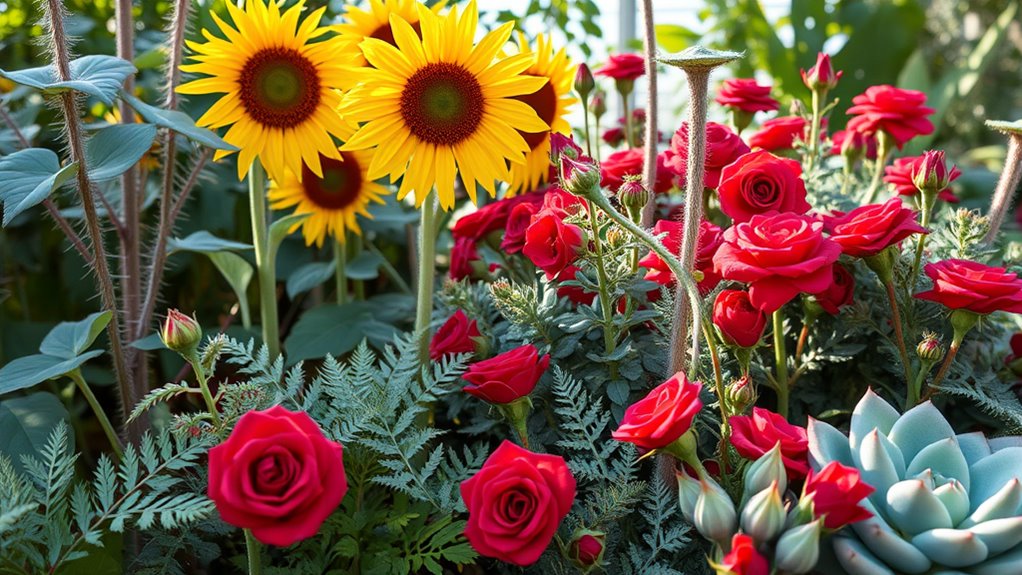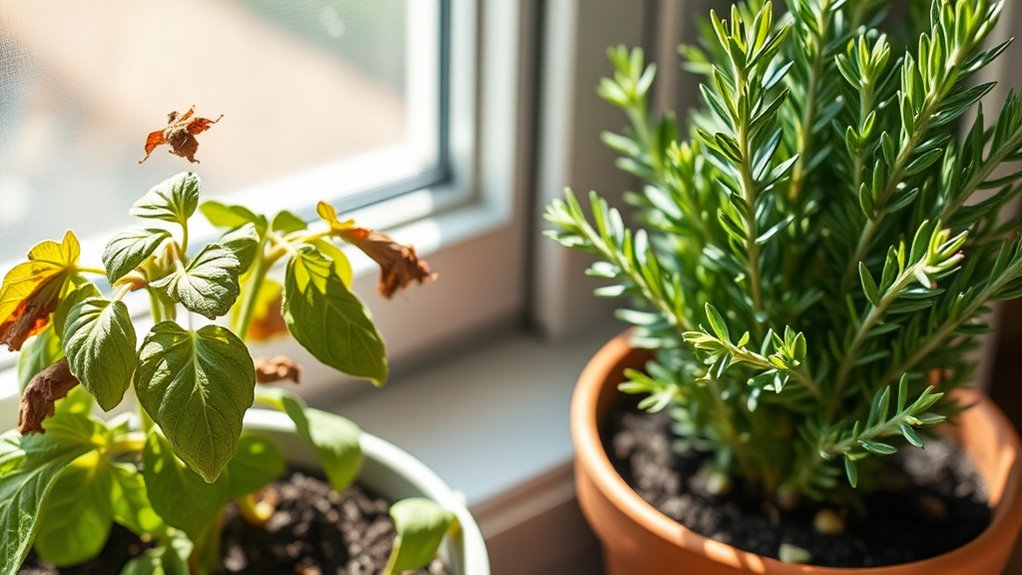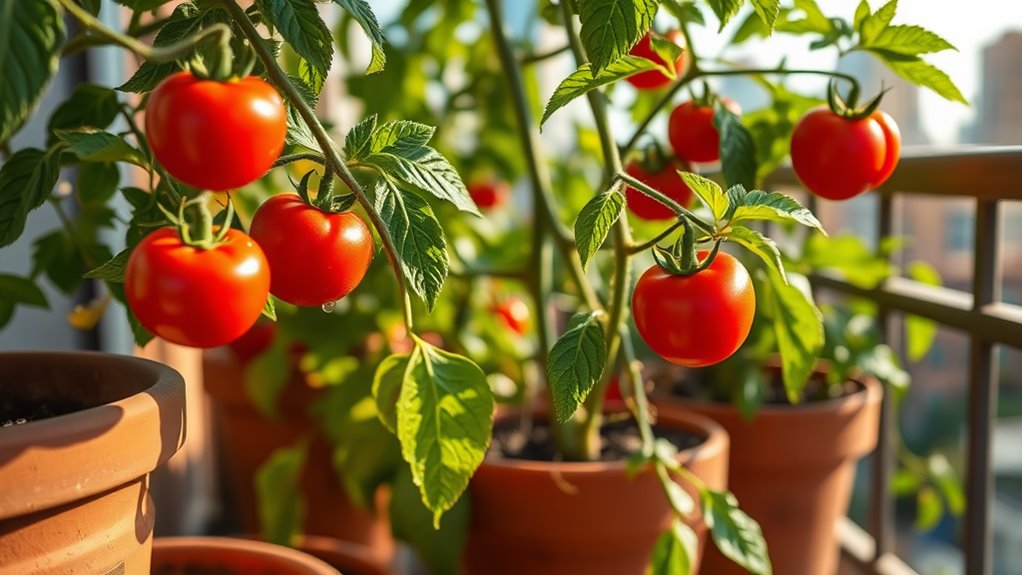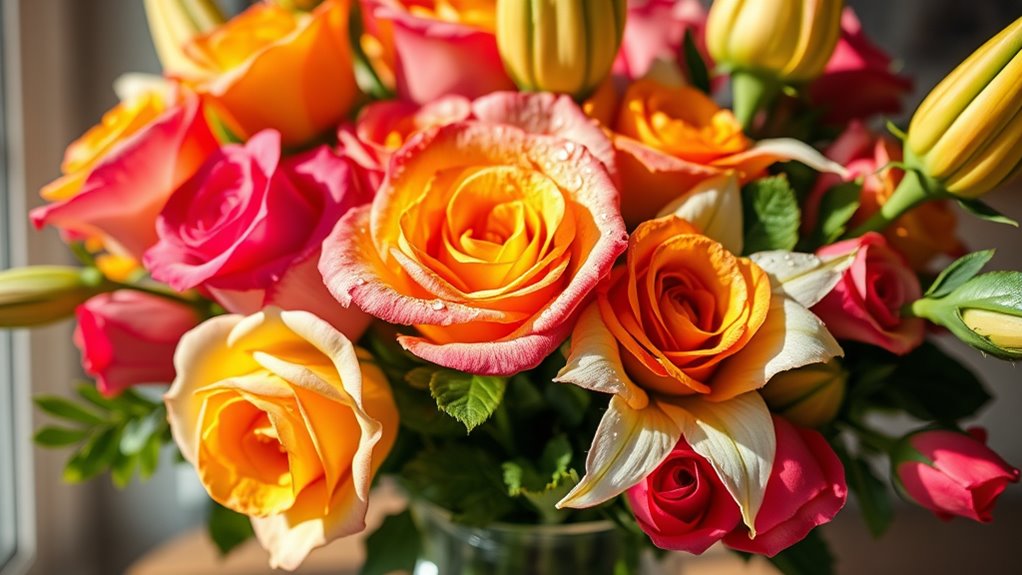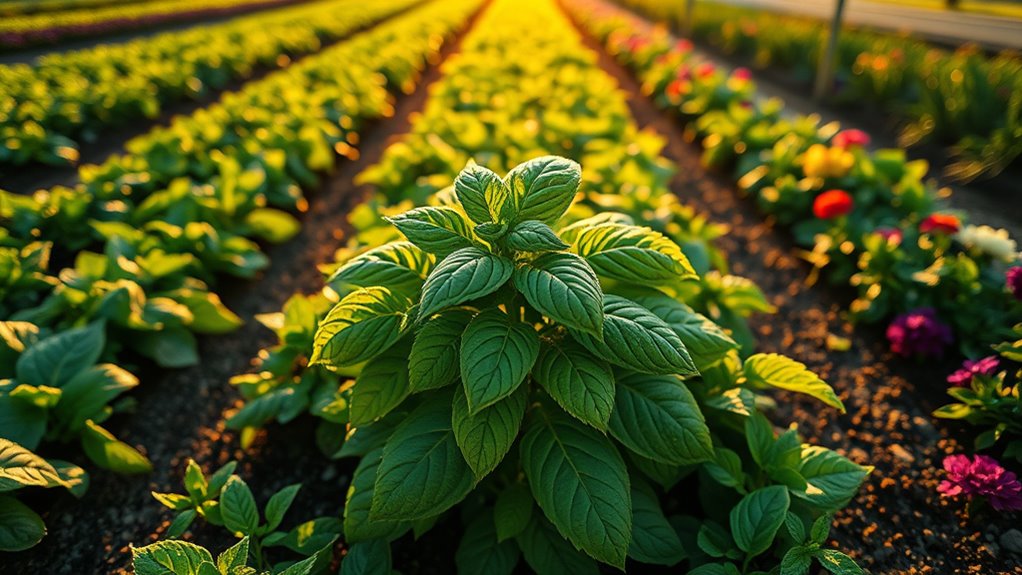You’re Not Pairing Your Plants Right (And It Shows)
If you’re not pairing your plants right, you’re probably stunting growth by ignoring soil needs or overcrowding, which invites pests and reduces yields. Pair tomatoes with basil to repel insects and enhance flavor, or marigolds with roses for better soil health. Watch for signs like stunted growth or leaf discoloration to spot issues early. Fine-tune by matching light and nutrient demands, and you’ll unlock a more vibrant garden—more strategies follow to elevate your setup.
Key Takeaways
- Avoid pairing aggressive growers with delicate plants to prevent stunted growth and competition.
- Match plants with similar light, soil, and water needs for optimal health and harmony.
- Use companion planting, like tomatoes with basil, to repel pests and enhance growth.
- Watch for signs of ineffective pairings, such as pest outbreaks or leaf discoloration.
- Regularly test soil and adjust pairings to boost yields and garden resilience.
Common Mistakes in Plant Pairing
When you’re pairing plants in your garden, you might inadvertently choose incompatible combinations that hinder growth or invite pests.
One key companion planting tip is to avoid pairing aggressive growers with delicate ones, as they compete for nutrients and space, stunting development.
Don’t ignore soil preferences; mixing plants with vastly different pH needs leads to poor health.
Overcrowding is another mistake—you’re blocking sunlight and airflow, fostering disease.
Always check for allelopathic effects, where one plant inhibits another’s growth through chemical release. By implementing companion planting strategies, you can enhance garden health and increase crop yields while deterring pests.
To enhance your garden further, explore specific plant combinations that promote healthier growth and deter pests based on scientific principles.
Follow these tips to prevent these errors and promote a thriving garden.
Ideal Companion Plant Combinations
Now that you’re exploring ideal companion plant combinations, you’ll find that pairing vegetables like tomatoes with basil boosts growth and repels pests effectively. In my first experience with this technique, companion planting detailed the plants chosen and the challenges faced, inspiring novice gardeners to try it.
When selecting flower companions, such as marigolds with roses, you enhance soil health and deter insects for a thriving garden.
For herb combinations, like rosemary with sage, you create mutually beneficial setups that optimize space and flavor in your planting areas.
Additionally, the companion plant pairing of basil with tomatoes enhances flavor and increases pest resistance in your garden.
Vegetable Pairings
While some gardeners overlook companion planting, you’ll find that pairing vegetables strategically boosts growth, deters pests, and maximizes space.
For instance, grow beans with corn in the Three Sisters method; beans fix nitrogen to fuel corn’s development, while corn provides support. Add squash to suppress weeds and retain soil moisture.
Plant onions near carrots to repel carrot flies with their pungent aroma. Intermix fast-growing radishes with slower beets to utilize vertical space efficiently.
These practical pairings enhance yields, foster resilience, and create a balanced vegetable garden ecosystem.
Flower Companions
Flowers, like vegetables, flourish through thoughtful pairings that boost pollination, ward off insects, and optimize garden space.
In your garden, you’ll enhance flower vitality by choosing companions that share similar needs and mutual benefits, creating a balanced, low-maintenance ecosystem.
- Pair marigolds with roses to repel aphids and nematodes effectively.
- Combine lavender with echinacea to attract bees and butterflies for better pollination.
- Use zinnias alongside sunflowers to maximize vertical space and color diversity.
- Plant alyssum with dahlias to suppress weeds and deter pests naturally.
Herb Combinations
Herbs thrive when paired with compatible plants, allowing you to boost flavor, deter pests, and maximize garden space efficiently.
For instance, you pair basil with tomatoes to enhance their taste and repel hornworms, while chives alongside carrots ward off aphids effectively.
Rosemary works well with beans, deterring bean beetles and promoting growth.
Dill attracts beneficial insects when planted near cabbage, aiding pest control.
These combinations optimize your garden’s health; always consider soil, water, and sunlight needs for best results.
Experimenting with these pairings boosts yields and minimizes chemical use in your herb setup.
Signs of Ineffective Plant Pairings
How can you spot signs of ineffective plant pairings? In your garden, you’ll notice clear indicators like stunted growth or increased pests, signaling that plants aren’t thriving together due to incompatible needs.
-
Stunted growth: Your plants compete fiercely for nutrients and space, resulting in smaller, underdeveloped foliage.
-
Pest outbreaks: Incompatible pairings attract more insects and diseases, weakening plant defenses.
-
Leaf discoloration: Mismatched light or water requirements cause yellowing, wilting, or spotting on leaves.
-
Reduced yields: Ongoing stress from poor pairings leads to fewer flowers, fruits, or overall production.
By recognizing these signs, gardeners can avoid harmful veggie pairings and promote thriving gardens.
To address these issues effectively, gardeners can explore companion planting strategies that promote healthier plant interactions and boost garden productivity.
Strategies for Better Plant Matching
You match plants by their environmental needs, such as light and soil type, to create a harmonious setup.
Next, you select pairings that boost aesthetics, like complementary colors and textures, for a visually striking garden.
Then, you balance nutrient demands to avoid depletion and support overall plant health. It’s also essential to avoid planting Vegetables That Don’t Get Along to prevent negative growth effects.
Incorporating Perfect Plant Pairs can further transform your garden into a flourishing ecosystem by enhancing growth and overall health.
Pair by Environment
When pairing plants, matching their environmental needs—such as light, soil, and moisture levels—helps avoid common pitfalls and fosters healthier growth.
You’re creating a balanced ecosystem by aligning these factors, so your plants thrive without stress or competition.
-
Assess light exposure: Pair sun-loving species together to prevent shading, ensuring uniform photosynthesis and vigor.
-
Match soil preferences: Group plants that need well-drained, acidic soil to avoid nutrient imbalances and root diseases.
-
Synchronize moisture requirements: Combine drought-resistant types to streamline watering and reduce rot risks.
-
Align climate tolerances: Select companions for similar temperature needs to minimize shock and promote steady growth.
Select for Aesthetics
Beyond environmental compatibility, selecting plants for aesthetics involves strategically matching colors, textures, and forms to create visually harmonious arrangements that elevate your garden’s appeal.
You achieve this by consulting a color wheel to pair complementary hues, like vibrant oranges with deep purples, for eye-catching contrast.
Experiment with textures—combine smooth, glossy leaves with rugged, feathery ones to add depth.
For forms, blend upright structures with cascading ones to layer your space.
Regularly evaluate your layout; tweak placements to ensure every element enhances the overall visual flow.
Balance Nutrient Needs
Balancing nutrient needs ensures your plants thrive together, so you match species with similar soil requirements to prevent competition. This means assessing pH levels, nutrient demands, and uptake rates to create harmonious pairings that boost overall garden health.
-
Test soil regularly: Use kits to check pH and nutrient levels, ensuring compatibility before planting.
-
Group by nutrient profiles: Pair heavy feeders like tomatoes with moderate ones like basil to avoid depletion.
-
Monitor and adjust: Track growth and amend soil with organic matter or fertilizers as needed.
-
Rotate companions: Switch plant partners seasonally to maintain balanced soil fertility and prevent exhaustion.
Benefits of Proper Plant Pairing
Proper plant pairing maximizes your garden’s health and productivity by strategically combining species that support each other.
You’ll enhance soil fertility as certain plants fix nitrogen or deter pests naturally, reducing your chemical needs. For instance, marigolds repel nematodes, protecting nearby roots, while beans enrich the soil for companions.
This synergy boosts yields—you’ll harvest more vibrant produce—and promotes biodiversity, making your ecosystem resilient to diseases. Furthermore, integrating eco-friendly methods can protect your plants from pests without relying on chemicals.
Additionally, by using natural methods like easily accessible staples to prevent pests, you can maintain a thriving garden ecosystem that complements your plant pairings.
Tips for Optimizing Your Garden Layout
As you plan your garden layout, prioritize factors like sunlight patterns and plant spacing to boost efficiency and health. Before diving in, assess soil health to lay a strong foundation. This approach minimizes competition for resources and enhances overall productivity.
You’ll integrate elements like soil types and microclimates to create a balanced ecosystem.
Additionally, incorporate seasonal strategies to maintain a vibrant garden across all seasons.
-
Assess sunlight exposure: Map daily sun angles to position plants correctly, avoiding shade mismatches.
-
Optimize spacing: Measure mature plant sizes to ensure air flow, reducing disease risks.
-
Group by needs: Cluster species with similar water and nutrient requirements for efficient irrigation.
-
Incorporate pathways: Design accessible paths to facilitate maintenance without compacting soil.

